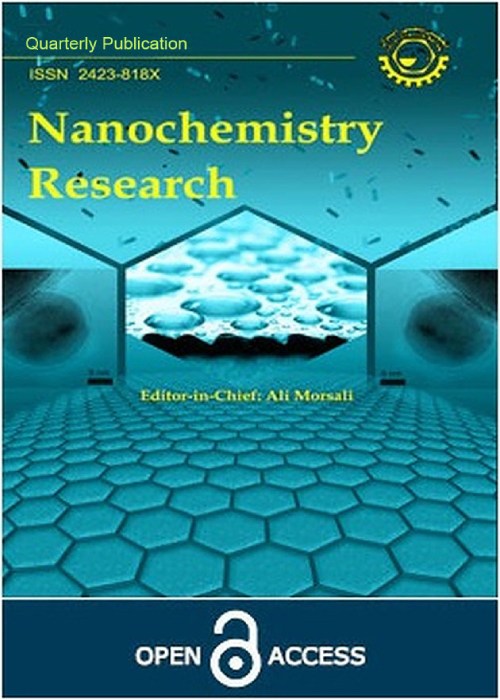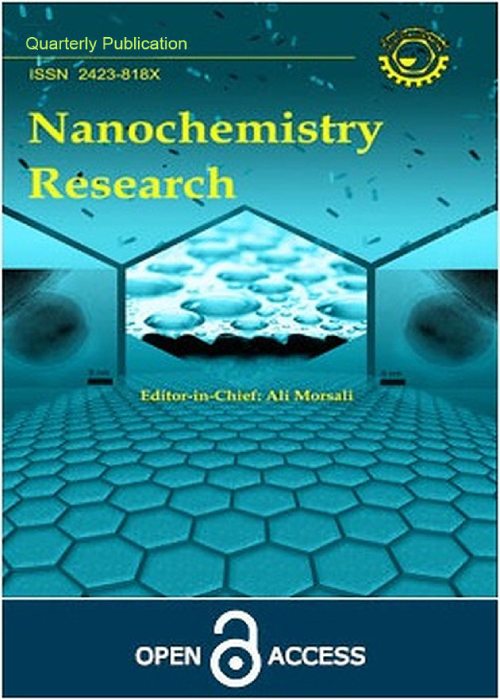فهرست مطالب

Nanochemistry Research
Volume:8 Issue: 1, Winter 2023
- تاریخ انتشار: 1402/01/20
- تعداد عناوین: 8
-
-
Pages 1-22
Magnetic nanocomposites of nickel ferrite nanoparticles, uniformly dispersed in the silica matrix, were synthesized successfully by a sol-gel process using tetraethyl orthosilicate (TEOS) and metallic nitrates as precursors. NiFe2O4@SiO2@HKUST-1 magnetic nanocomposites were synthesized and characterized by transmission electron microscopy (TEM), scanning electron microscopy (SEM), X-ray diffraction (XRD), Fourier transform infrared spectrometry (FTIR), vibrating sample magnetometry (VSM), nitrogen adsorption porosimetry, Thermal Analysis (TGA), photoluminescence analysis, and UV-visible. The more acidic pHs and lower concentrations of the dye solution, the less the dye molecules are present in the solution; therefore, the pore volumes and surface areas will be filled slowly and with higher removal efficiency. Magnetic nanocomposite of metal-organic, ferrite-nickel, and silica framework have high efficiency and absorbability for cationic dyes such as methylene blue. Within 60 minutes, approximately 98% of the dye molecules were removed using the magnetic metal-organic framework nanocomposite 30% NiFe2O4@SiO2@HKUST-1 under optimum condition. Adsorption isotherms, kinetics, and adsorption studies have shown that R2 is the most frequent Freundlich isotherm, which means that the adsorption process was mainly multilayered on heterogeneous surfaces of the metal-organic framework nanocomposites.
Keywords: Metal-organic framework, Methylene blue, Dye removal, Wastewater, Magneti, nanocomposite -
Pages 23-30
Nano-Ag as a green heterogeneous catalyst was utilized for the synthesis of furans by the three-component reaction of phenylglyoxal, dimethyl acetylenedicarboxylate, and primary amines. The best results were obtained in the presence of 4 mol% of nano-Ag in CH2Cl2 at room temperature. The nanocatalyst was characterized by UV-VIS, FT-IR, XRD, SEM and EDS. Ag nanostructures were prepared using extract of Echium amoenum. Some of the substantial features of this method include experimental simplicity, wide range of products, excellent yields in short reaction times, reusability of the catalyst, and low catalyst loading.
Keywords: Nano-Ag, One-pot, Phenylglyoxal, Furancarboxylate, Nanocatalyst -
Pages 31-39
Zinc oxide nanoparticles are one of the known safe compounds, and their low toxicity makes them suitable for waste water remediation. An environment-friendly approach of synthesizing nanoparticles is the use of plant extracts which are rich sources of phytochemicals as reducing agents. In this research, aqueous extracts of four different plants’ leaves were analyzed and found to contain anthocyanins, steroids, phenolics, saponins, flavonoids, and terpenoids. Optimization study prepared the precursors (zinc salt and plant extracts) in varying volume-ratios of 1:1, 1:2 and 2:1; a higher yield was observed for the ratio 1:1 having calculated percentage yields of 50.0 %, 64.1 %, 21.8 %, and 68.0 % for leaves of guava, tropical almond, lemon, and Mexican a, respectively. The TEM characterization of these biosynthesised nanoparticles have sizes in the range 0.22 nm and 5.80 nm, while the EDS spectra presented these nanoparticles as highly pure having major elements of zinc and oxygen. The small sizes and very high purity of the biosynthesised nanoparticles make them fit for adsorption applications such as waste water remediation.
Keywords: ZnO nanoparticles, Phytochemical, Aqueous leave extract, EDS, TEM, Percentage yield -
Pages 40-49
Azacitidine, known under the brand Vidaza, has therapeutic applications for several health complications, including myelodysplastic syndrome, myeloid leukemia, and juvenile myelomonocytic leukemia. The fullerene, mainly C60, has many attractive properties such as physical and electrochemical properties, which can be useful for drug delivery. The current research has focused on the characteristics of Azacitidine concerning its reactivity and chemical structure, which may contribute to its anti-cancer effects. Accordingly, the process of Azacitidine adsorption on fullerene adsorbent was investigated in the gas phase utilizing DFT/B3LYP/6-311+G(d, p). The adsorption process on the adsorbent molecule was examined from a chemical perspective, along with the calculation of the adsorption energy. In addition, the chemical structure (dipolar moment (μ=2.56705)), thermodynamic features consisting of Gibbs free energy (-2354.94 kJ), enthalpy (-2354.80 kJ), entropy (+495.49 J/mol-kelvin), and thermodynamic capacity (226.74 J/mol-kelvin), together with effective electronic parameters such as (σ(0.15), μ(-3.49), ω(0.93), χ(3.49), and η(6.51) all data in eV ) in illustrating the compound’s chemical characteristics were estimated. Calculating the HOMO(-10.00 eV) and LUMO(3.02 eV) energy levels showed nine regions with chemical activity for Azacitidine, confirming that it is thermodynamically stable while also highlighting the role of this adsorption in Azacitidine delivery to biological mechanisms. Better nucleophilic behaviors can be obtained because the oxygen of the carbonyl group is more negatively charged due to the resonance happening for this molecule. The complex of Azacitidine with fullerene shows decrease in Chemical potential which illustrates more reactivity for the Complex.
Keywords: Azacitidine, Fullerene, DFT, Anti-cancer, Drug -
Pages 50-56
Metal-organic frameworks as porous materials are highly advantageous over other porous carriers like mesoporous silica or zeolites. They provide advantages for biomolecule release and their adsorption characteristics offer many opportunities. Thus, they present high applicability in medicine and biology. Metal-organic frameworks (MOF) possess appealing structures and usages including high surface area, homogenous structured nanoscale cavities, and excellent thermal stability. Therefore, they can be a new sorbent alternative for preparing samples. In the present study, a MOF fiber application for solid-phase microextraction is reported. The MOF fiber is in nano size and has a high surface area. 3D and oriented organizations of MOF materials are vital so that they may be utilized as the fiber coating for microextraction in solid-phase for volatile substances in the medicinal herbs. In order to make Cu-based MOFs into three-dimensional hierarchical nanoarray structures, a coordination replication approach is created. To this end, Cu(OH)2 nanorod arrays are used as a sacrificial template. Cu(OH)2 nanorod arrays serving as Cu origin provided coordination with organic ligands for forming MOF crystals and 3D substrate for supporting Cu-based MOF growth. Following the presentation of the fiber, essential oils of Satureja hortensis L were determined using GC-MS. Ease of use, shorter analysis period, inexpensive tools as well as a high rate of recovery are advantages of the proposed approach compared to ordinary analysis approaches.
Keywords: Essential oil, Metal–organic frameworks, Microextraction (MOFs), Satureja hortensis L -
Pages 57-70
Currently, most drugs reach to their place where they can have their desired effects through traditional methods and systemic absorption. Drugs are associated with many problems and complications in drug delivery systems the aim of which is reducing the frequency of drug usage and optimizing the effect of the drug. Therefore, by providing effective drug concentrations in the damaged organ, the therapeutic effect of the drug is enhanced and its degradation is reduced. In addition, this maintains the circulation of the drug in the blood for a longer time and can diminish its side effects. There are different types of drug delivery systems (DDS) of most advanced types for nanostructured carriers in design and fabrications. Solid lipid nanoparticles (SLN) form colloidal drug carrier systems are an alternative to colloidal carriers such as liposomes, emulsions, and micro polymeric components. For the synthesis of these particles, many methods are applied which provide the possibility of loading various hydrophobic and hydrophilic drugs inside the lipid nanoparticles. In this article, various methods and application of these lipids in targeted drug delivery system are reviewed.
Keywords: Solid lipid nanoparticles, Targeted drug delivery, Nanocarrier, Polymeric, Dental materials -
Pages 71-77
A Bi2O3 nanomaterial was fabricated by a facile and low temperature solid state method using a basic bismuth nitrate raw compound at 400 ˚C and 14 h. Rietveld analysis data indicated that α-Bi2O3 was crystallized well in monoclinic crystal system with the space group of P121/c1. The morphology of the synthesized material was studied by field emission scanning electron microscope (FESEM). The direct band gap energy (Eg) value was calculated by ultraviolet – visible (UV-Vis) spectroscopy. The peaks at 400 – 550 cm-1 are assigned to oxygen – metal – oxygen (O-M-O) vibrations. The data showed that the Eg of the synthesized material was about 2.2 eV. In addition, the vibrating-sample magnetometer (VSM) analysis data confirmed that the synthesized sample had ferromagnetic behavior. Further, gas sensing property of the synthesized Bi2O3 nanomaterial for carbon monoxide gas was studied, and the data confirmed the good sensitivity of the prepared sensor at low CO concentrations.
Keywords: Rietveld, Solid State, Magnetic Property, CO gas sensing -
Pages 78-86
In this work, silver nanoparticles/chitosan nanocomposites were prepared for possible industrial and biomedical applications. Chemical reduction of silver nitrate salt produced silver nanoparticles (AgNPs). Low molecular weight chitosan (LMWCS) which connotes artificial chitosan (ArCS) was obtained, and biodegradable chitosan was extracted from snail shells using standard procedures. Sodium tripolyphosphate (TPP) was used to produce chitosan nanoparticles (snail shell nanochitosan (ScCSNPs) and artificial nanochitosan (ArCSNPs)) from extracted chitosan and LMWCS. AgNPs-CSNPs were produced by incorporating AgNPs into CSNPs as antimicrobial agents. Characterization of the chitosan doped silver nanoparticles was conducted using scanning electron microscopy (SEM), Fourier Transform Infrared Spectroscopy (FTIR), Differential Scanning Calorimetry (DSC) and X-ray Diffraction (XRD). The morphological properties of nanochitosan (ScCSNPs and ArCSNPs) and AgNPs-nanochitosan (ScCSNPs-AgNPs and ArCSNPs-AgNPs) indicated porosity and agglomeration, while functional groups -OH, -NH, and C-H were revealed. The presence of AgNPs in the polymeric matrix of nanochitosan was confirmed by a shift in some of the adsorption bands. XRD and DSC results revealed that the nanochitosan is crystalline, and they also confirmed the presence of AgNPs in the chitosan polymeric matrix. The study established that chitosan extracted from snail shells, which contribute to environmental pollution, could be a good source for the preparation of nanocomposite materials, which are useful in a variety of industrial and biomedical applications.
Keywords: Chitosan, Biowaste, Nanoparticles, Silver, Spectroscopy


